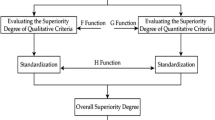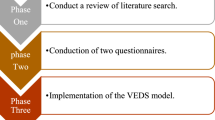Abstract
It is possible to obtain better, qualified and error-free structures by evaluating the multidimensional criteria reflects all manner of opinions in the building production process. Stakeholders’ integration plays a major role in achieving this evaluation expecting the targeted quality in building production, and different priorities could be defined by various type of stakeholders. Therefore, applicable approaches should be used where the stakeholders of the building production process will be included to determine priority levels of criteria. All the criteria considered should provide that all dimensions of demands and expectations are met in the creation of the new building and the built environment. In this study, which is a widely used multi-criteria decision-making method, is applied to ensure mutual satisfaction of decision-makers and beneficiaries in construction process. Four main criteria and sub-criteria related to these main criteria were determined by adding “green and sustainability issues” to the “functionality”, “build quality” and “impact” trilogy determined by Vitruvius for the development of architectural quality. The method used here is based on an evaluation system takes into account all of the stakeholders’ expressions. Necessary data is gathered from three type of stakeholders; a technical team of five individuals consists of architects and engineers, a focus group of twelve individuals consist of occupiers as mass housing clients and the last one is the focus group of three individuals from building production firms as facilities manager. It was observed that distinct type of stakeholder ranked the weight of each main and sub-criterion differently. Therefore, it has been concluded that definition of criteria and determination of the weights of them shall not be determined by only one stakeholder in a project, but also all particular stakeholder are also shall be included during planning and application process.




Similar content being viewed by others
Abbreviations
- MCDM:
-
Multiple criteria decision making
- AHP:
-
Analytic hierarchy process
- PROMETHEE:
-
Preference ranking organization method for enrichment evaluations
- TOPSIS:
-
Technique for order preference by similarity to ideal solution
- ELECTRE:
-
Elemination and choice translating reality english
- DQI:
-
Design quality indicator
- HQI:
-
Housing quality indicator
- HQS:
-
Housing quality standart
- POE:
-
Post-occupancy evaluation
- ODPM:
-
Office of the deputy prime minister
- GDM:
-
Group decision-making
- CI:
-
Consistency index
- CR:
-
Consistency ratio
- RI:
-
Random consistency index
References
Abdel-Basset, M., et al. (2018). Three-way decisions based on neutrosophic sets and AHP-QFD framework for supplier selection problem. Future Generation Computer Systems, 89, 19–30
Abdirad, H., & Nazari, A. (2015). Barriers to effective implementation of quality management systems in public design projects in Iran. Architectural Engineering and Design Management, 11(6), 457–474
Adinyira, E., Kwofie, T., & Quarcoo, F. (2018). Stakeholder requirements for building energy efficiency in mass housing delivery: The House of Quality approach. Environment, development and sustainability, 20(3), 1115–1131
Alanne, K., et al. (2007). Multi-criteria evaluation of residential energy supply systems. Energy and buildings, 39(12), 1218–1226
ASCE. (2012). Quality in the constructed project: A guide for owners, designers, and constructors. VA: ASCE Reston.
Awasthi, A., & Chauhan, S. S. (2012). A hybrid approach integrating affinity diagram, AHP and fuzzy TOPSIS for sustainable city logistics planning. Applied Mathematical Modelling, 36(2), 573–584
Baird, G. (1996). Building evaluation techniques. McGraw-Hill Professional Publishing.
Bernus, P., Nemes, L., & Schmidt, G. (2012). Handbook on enterprise architecture. Springer Science & Business Media.
Beynon, M. J. (2006). The role of the DS/AHP in identifying inter-group alliances and majority rule within group decision making. Group decision and negotiation, 15(1), 21–42
Bhatia, R., & Singh, M. (2015). Preserving privacy in healthcare web services paradigm through hippocratic databases. Intelligent Computing, Communication and Devices. (pp. 177–188). Springer.
Blyth, A., & Worthington, J. (2002). Managing the brief for better design. Taylor & Francis.
Boschi, N. (2002). Quality of life: Meditations on people and architecture. Monterey (CA). In: Levin, H. (Ed.), Proceedings of Indoor Air ’02. ISBN 0-9721832-0-5.
Brophy, V., & Lewis, J. O. (2012). A green vitruviu principles and practice of sustainable architectural design. Routledge.
Cook, M. (2008). The design quality manual improving building performance. Wiley.
Cornick, T. (2006). Construction quality and management—its delivery and discipline in housing and other building sectors. (p. 471). Management, Quality Economics in Building.
Deming, W. E. (1952). Elementary principles of the statistical control of quality. UK: Oxford Press.
Deng, H. (1999). Multicriteria analysis with fuzzy pairwise comparison. International Journal of Approximate Reasoning, 21(3), 215–231
Dinc, P., Özbilen, E., & Bilir, M. B. (2014). A multi-dimensional scale for measuring residential satisfaction (rs) in mass housing projects. Indoor and Built Environment, 23(6), 864–880
Gann, D., Salter, A., & Whyte, J. (2003). Design quality indicator as a tool for thinking. Building research & information, 31(5), 318–333
Gass, S. I., & Rapcsák, T. (2004). Singular value decomposition in AHP. European Journal of Operational Research, 154(3), 573–584
Gibson, E., & Gebken, R. (2003). Design quality in pre-project planning: Applications of the project definition rating index. Building Research & Information, 31(5), 346–356
Harputlugil, T., Gültekin, A.T., Prins, M., & Topcu, Y.I. (2016). Architectural design quality assessment based on analytic hierarchy process: A case study. METU Journal of the Faculty of Architecture, 31(2).
Ho, W., & Ma, X. (2018). The state-of-the-art integrations and applications of the analytic hierarchy process. European Journal of Operational Research, 267(2), 399–414
Hsieh, T.-Y., Lu, S.-T., & Tzeng, G.-H. (2004). Fuzzy MCDM approach for planning and design tenders selection in public office buildings. International journal of project management, 22(7), 573–584
Juran, J. M. (1974). Quality Control Handbook. McGraw-Hill.
Kamaruzzaman, S. N., et al. (2018). Developing weighting system for refurbishment building assessment scheme in Malaysia through analytic hierarchy process (AHP) approach. Energy Policy, 112, 280–290
Kazaz, A., & Birgonul, M. T. (2005). Determination of quality level in mass housing projects in Turkey. Journal of construction engineering and management, 131(2), 195–202
Kondo, Y. (2000). Attractive quality: its importance and the points of remark. Total Quality Management, 11(4–6), 647–651
Kowaltowski, D. C., et al. (2019). A critical analysis of research of a mass-housing programme. Building Research & Information, 47(6), 716–733
Kuruüzüm, A., & Atsan, N. (2001). Analitik Hiyerarşi Yöntemi ve İşletmecilik Alanındaki Uygulamaları. Akdeniz University Faculty of Economics & Administrative Sciences Faculty Journal, 1(1), 83–105
Lang, J. T. (1974). Designing for human behavior: Architecture and the behavioral sciences. (Vol. 6)Dowden, Hutchinson & Ross.
Le, L. H., Ta, A. D., & Dang, H. Q. (2016). Building up a system of indicators to measure social housing quality in Vietnam. Procedia engineering, 142, 116–123
Li, T. H., Ng, S. T., & Skitmore, M. (2012). Conflict or consensus: An investigation of stakeholder concerns during the participation process of major infrastructure and construction projects in Hong Kong. Habitat International, 36(2), 333–342
Li, T. H., Thomas Ng, S., & Skitmore, M. (2016). Modeling multi-stakeholder multi-objective decisions during public participation in major infrastructure and construction projects: A decision rule approach. Journal of Construction Engineering and Management, 142(3), 04015087
Malakouti, M., et al. (2019). Evaluation of flexibility components for improving housing quality using fuzzy TOPSIS method. Journal of Building Engineering, 22, 154–160
Mareschal, B. (1988). Weight stability intervals in multicriteria decision aid. European Journal of Operational Research, 33(1), 54–64
Mast, B. D. (2009). Measuring housing quality in the housing choice voucher program with customer satisfaction survey data. A Journal of Policy Development and Research, 11(2), 101–112.
Mlecnik, E., Visscher, H., & Van Hal, A. (2010). Barriers and opportunities for labels for highly energy-efficient houses. Energy Policy, 38(8), 4592–4603
Mulliner, E., Smallbone, K., & Maliene, V. (2013). An assessment of sustainable housing affordability using a multiple criteria decision making method. Omega, 41(2), 270–279
Pekuri, A., Haapasalo, H., & Herrala, M. (2011). Productivity and performance management–managerial practices in the construction industry. International Journal of Performance Measurement, 1(1), 39–58
Preiser, W. F., & Nasar, J. L. (2008). Assessing building performance: Its evolution from post-occupancy evaluation. International Journal of Architectural Research: ArchNet-IJAR, 2(1), 84–99
Preiser, W., & Vischer, J. (Eds.). (2006).Assessing building performance. Oxford: Elsevier.
Razavi, M., Aliee, F. S., & Badie, K. (2011). An AHP-based approach toward enterprise architecture analysis based on enterprise architecture quality attributes. Knowledge and information systems, 28(2), 449–472
Rounce, G. (1998). Quality, waste and cost considerations in architectural building design management. International Journal of Project Management, 16(2), 123–127
Rowland, I. D., & Howe, T. N. (2001). Vitruvius: ‘Ten books on architecture.’ Cambridge University Press.
Saaty, R. W. (1987). The analytic hierarchy process—what it is and how it is used. Mathematical modelling, 9(3–5), 161–176
Saaty, T. L. (1990). How to make a decision: the analytic hierarchy process. European journal of operational research, 48(1), 9–26
Sabaei, D., Erkoyuncu, J., & Roy, R. (2015). A review of multi-criteria decision making methods for enhanced maintenance delivery. Procedia CIRP, 37, 30–35
Safapour, E., et al. (2019). Identifying effective project-based communication indicators within primary and secondary stakeholders in construction projects. Journal of Legal Affairs and Dispute Resolution in Engineering and Construction, 11(4), 04519028
Sanni-Anibire, M. O., Hassanain, M. A., & Al-Hammad, A.-M. (2016). Post-occupancy evaluation of housing facilities: Overview and summary of methods. Journal of Performance of Constructed Facilities, 30(5), 04016009
Sarathy, P. S. (2013). TQM practice in real-estate industry using AHP. Quality & Quantity, 47(4), 2049–2063
Sikorsky, C. S. (1990). Product and process integration for the US design-construction industry. Texas A & M University.
Simon, H., A. (1962). The architecture of complexity. In Proceedings of the American philosophical society, vol 106(6), pp 467–482
Svahnberg, M., et al. (2003). A quality-driven decision-support method for identifying software architecture candidates. International Journal of Software Engineering and Knowledge Engineering, 13(05), 547–573
Thanki, S., Govindan, K., & Thakkar, J. (2016). An investigation on lean-green implementation practices in Indian SMEs using analytical hierarchy process (AHP) approach. Journal of Cleaner Production, 135, 284–298
Thomson, D. S., et al. (2003). Managing value and quality in design. Building Research & Information, 31(5), 334–345
Triantaphyllou, E. (2000). Multi-criteria decision making methods. Multi-criteria decision making methods: A comparative study. (pp. 5–21). Springer.
Uzun, S., & Kazan, H. (2016). Çok kriterli karar verme yöntemlerinden AHP TOPSIS ve PROMETHEE karşılaştırılması: Gemi inşada ana makine seçimi uygulaması. Journal of Transportation and Logistics, 1(1), 99–113
Vafaei, N., Ribeiro, R. A., & Camarinha-Matos, L. M. (2016). Normalization techniques for multi-criteria decision making analytical hierarchy process case study. Doctoral conference on computing electrical and industrial systems (pp. 261–269). Springer.
Volker, L., et al. (2008). Deciding about design quality: Design perception during a European tendering procedure. Design Studies, 29(4), 387–409
Yau, Y. (2011). Multicriteria decision making for homeowners’ participation in building maintenance. Journal of Urban Planning and Development, 138(2), 110–120
Yudelson, J. (2010). Greening existing buildings (McGraw-Hill’s Greensource). New York, NY: McGraw-Hill.
Zavadskas, E. K., et al. (2018). Sustainable decision-making in civil engineering, construction and building technology. Sustainability, 10(1), 14
Author information
Authors and Affiliations
Corresponding author
Additional information
Publisher's Note
Springer Nature remains neutral with regard to jurisdictional claims in published maps and institutional affiliations.
Rights and permissions
About this article
Cite this article
Eryürük, Ş., Kürüm Varolgüneş, F. & Varolgüneş, S. Assessment of stakeholder satisfaction as additive to improve building design quality: AHP-based approach. J Hous and the Built Environ 37, 505–528 (2022). https://doi.org/10.1007/s10901-021-09855-8
Received:
Accepted:
Published:
Issue Date:
DOI: https://doi.org/10.1007/s10901-021-09855-8




